
Return to home page
Read August 2007 blog Read June 2007 blog
Read May 2007 blog Read April 2007 blog Read March 2007 blog
Read February 2007 blog Read January 2007 blog Read December 2006 blog
Go to my 2001-2 Australia travel book
Send a comment
Other blogs I'm reading: Christine Allen's // Gordon Price's // Sarah Jane's photo site
Go to the page on the Elizabeth Flats (where we live)
| September 29, 2007:
I've had some interesting correspondence from a woman named
Connie Kempter who lives in Quebec but once trained horses in South
Australia. She and her husband took a car trip around BC, Alberta and
Washington in the summer and fell in love with the Anarchist Mountain
area east of Osoyoos, ending up buying a property containing the
history Sidley cemetery where many of the early settlers are buried.
I've always had a real soft spot for those fabulous high pastures: it
was the view over the Lawless Ranch and the old Charlton
place near Bridesville that got me started on the Vanishing
BC project a dozen years ago. Connie wrote that their sudden
infatuation with Anarchist Mountain was triggered partly by its
resemblance to Australia. It is ironic, because part of the incentive
for me, as a painter, to move to Australia was the countryside's
resemblance to those rolling meadows of the Boundary Country. Connie's
website is www.rappenhof.qc.ca -Australia is a country of very colourful language but also one where the nuances of accent and pronunciation have all sorts of class connotations. Oz is not as bad as Britain, of course, and in most ways is a very egalitarian place, but you hear more "posh accents" -- i.e. people sounding more English -- on the Sydney north shore and, up here in the Mountains, at the slightly more exclusive towns of Wentworth Falls, Blackheath and especially Leura, just adjoining shabby-genteel Katoomba where we live. It's also very noticeable in politics. Prime Minister John Howard has been successful politically due to his appeal to the "battlers" in the mortgage belts around the big cities, though he lives in and represents a high-end Sydney riding, and has a real "Ocker" accent. The Leader of the Opposition, Kevin Rudd, has a comparatively refined one, but his deputy, Julia Gillard, who will likely be responsible for labour relations and union matters after the election, has a very broad workingman's drawl. And you hear it on the TV newscasts: the newsreaders on the commercial stations have much more posh accents than the sports reporters. All about cred with the target audience. Worst of all are the plummy accents on ABC Classical radio -- more English than the English. -Speaking of language, our goods from Canada were delayed in quarantine for a nail-biter of a day while the inspectors determined whether a bug that made the trip in the container was an "actionable insect." It was probably a house fly or something, but they were taking no chances!! If it had been a danger to the country, it would have cost a fortune to fumigate the entire load. Whew! |
| September 25, 2007:-in
the midst of world crises, Australia is focused on the National Rugby
League finals. That's unfair, of course -- like saying that Canada only
cares about the Stanley Cup in the spring. Rugby is the winter passion
here, wrapping up just as horse-racing begins (or would, if there
wasn't a major equine flu outbreak) and people begin to dust off their
cricket bats. In rugby, which is a professional sport with a myriad of
teams, the Manly Sea Eagles are battling the ... uh, I forget the other
team, except that they are from hated Melbourne and notorious for their
brutal tackles. The "grapple tackle" and "the ripper," in which the
defenders appear to be trying to rip the heads or arms off the guy with
the ball, have themselves become news items, with experts predicting
dire and permanent injuries as a result. -another $700 million in government grants to farmers today for drought relief. After a wet autumn, there has been almost no rain out in the west, with the Murray-Darling river system practically dry. The "La Nina" effect which was predicted to follow the series of dry El Nino years hasn't arrived, and a study released today by the scientific council suggested that the persistent drought pattern inland was likely to become chronic. When we drove back from Queensland a week ago, we were following the New England Highway, a corridor 100 km or so from the coast settled 150 years ago, and the pastures were green and, in some places, lush. And the Queensland we saw, as with some of the coastal parts of NSW, looked fabulous: tropical greens, miles of sugarcane plantations growing along the banks of rivers, and so on. There really are two Australias, defined by rainfall. -I gather there was a profile in Canadian newspapers of Peter Garrett, who will be the environment minister in a new Labour Government should they win the forthcoming federal election. Garrett is an interesting character, having been the frontman for rock band Midnight Oil before becoming an environmental activist and entering politics. At a party last weekend, I heard a number of people dissing him for allegedly backing down on his principles, compared with the almost-unelectable but ideologically pure Greens. It just shows the difference between advocating and governing and how he's making the transition to the latter. -I've been puzzled about the upcoming federal election, as the last one was held in 2004 and the one before that in 2001. It sounds like Canada under Chrétien, except he was sure to win and the John Howard government is almost certain to lose. Answer: the election mandate here is only 3 years, not the 5 in Canada, another way that taxpayers' money can be wasted while we all get distracted by watching sport. At least that's what Christine's cousin Christopher said. -when we went into Queensland, I was expecting to set my watch back an hour, as we had on previous trips there, and was surprised that they were on the same time as New South Wales. Answer: both States are still on Standard Time, but NSW will go onto Daylight Time at the end of September and Queensland won't. A Canadian instantly thinks of Saskatchewan, which has always resisted the witch-doctery of Daylight Savings, and Queensland is similarly an agricultural State. But according to an article in the newspaper, northern Queenslanders are fiercely opposed to Daylight Savings because it would mean one more hour of boiling sunshine during the usable part of the day. But as new hordes move onto the Gold Coast, further south, the lure of more daylight hours along the beach will likely change the vote. |
September 20, 2007:
Just back from an 8-day road trip to Queensland. We drove the 1000+
kilometres up the coast to Brisbane for a family party, taking 3 days
at it and reprising a trip we made in 1979. It was so different, so
built up from what we thought we remembered, that we could almost have
been on another part of the planet. Only the middle coast, near
Nambucca Heads and Coffs Harbour, retained something of the unspoiled
magic we'd hoped for.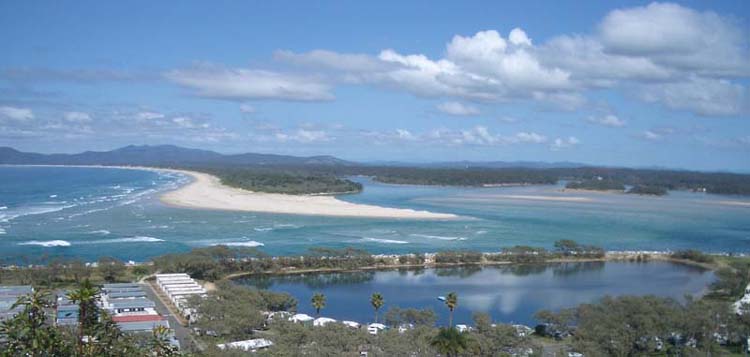 Like a lot of the towns on the New South Wales central coast, Nambucca Heads has lagoons separated from the ocean surf by a tidal break. |
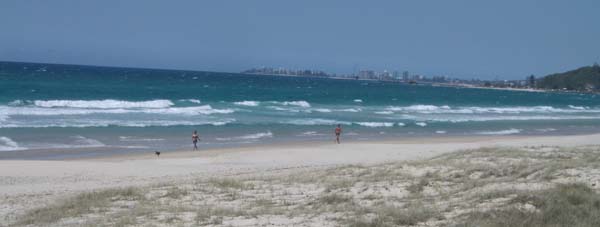 Nothing
prepares you for the scale of the development from Tweed Heads -- the
most northerly town in New South Wales -- in the distance above,
through to
Brisbane, with the towers and congestion of Surfer's Paradise
in the middle of the almost unbroken beach. Apparently 1500 people a week are moving
to the Gold Coast, the strip of coastline between Brisbane and Tweed
Heads. Similar large numbers are flocking to the Sunshine Coast north
of Brisbane. The beaches are sublime, but ....
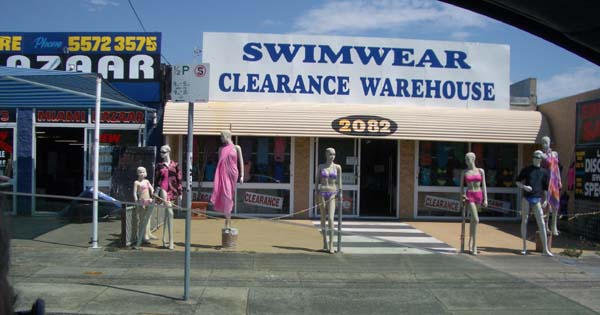 The roadways and strip malls within earshot of the surf are as tacky as anything in Santa Monica or Huntingdon Beach or anywhere else in Los Angeles. That's what it reminds me of: LA as it was in the 70s when I used to go there regularly. 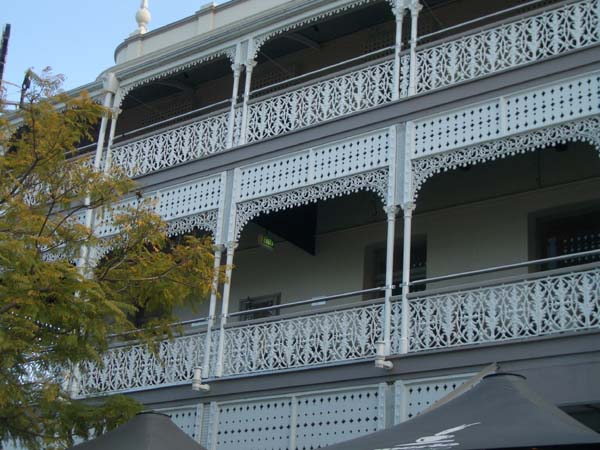 Above: the iron lace on the Regatta Hotel on the Brisbane River. Below: the water dragon -- about 2 feet from nose to tip -- who lived beside the pool at the motel where we stayed. Brisbane itself just gets better and better -- urban and walkable and interesting, in spite of the relentless heat and humidity. It wasn't even the vernal equinox yet, and the temperatures were in the high 20s. They are on Level 5 water restrictions, meaning they can't water anything in their gardens with "new" water. 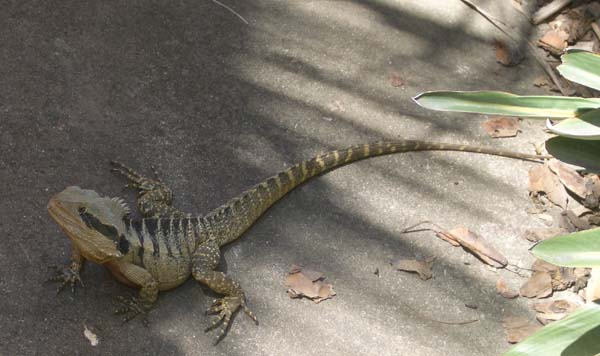 It being Australia, there were many Big Roadside Things. Continuing in the tradition of our trip southwards in May, I photographed every large object I came across. 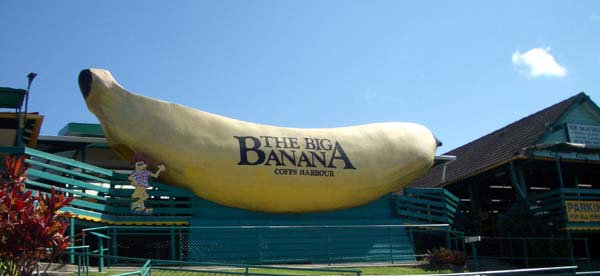 Above, a noted tourist attraction and, below, the roadside stand across the street from it. 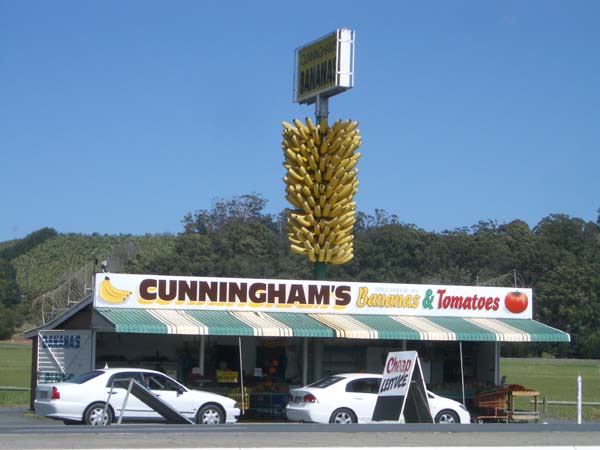 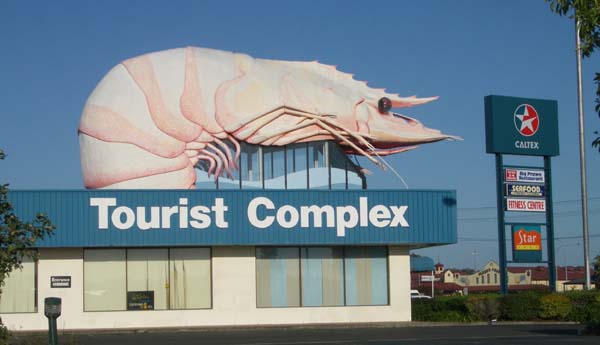 In Ballina, the Giant Prawn. The idea that tourists are complex in that part of Australia is a bit of a stretch. It's all surf and sun and clean white sheets in the resort hotels along the beaches. 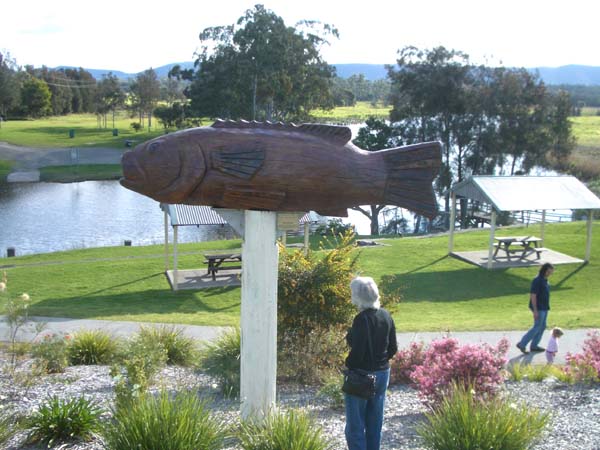 A Not-So-Giant Object: a sea-bass, I think it was, much further south at Bulahdelah. 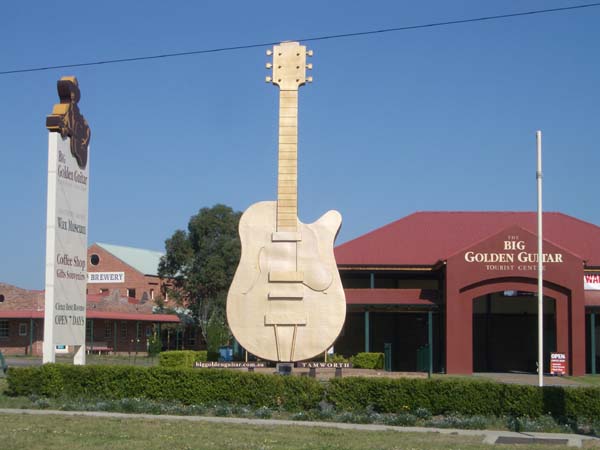 Roadside landmark in Tamworth, a central NSW town that hosts the annual country music festival. 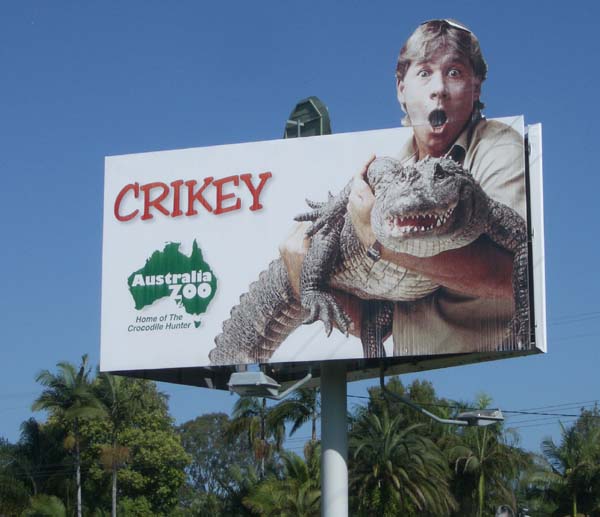 And, one of a squillion identical billboards on the roads north of Brisbane. The late Steve Irwin's zoo lives on, part of the swath of amusement parks on the Sunshine Coast. Since his death last year, the government has hastily renamed the road to the zoo, and plastered new "Steve Irwin Way" signs over the old ones. We didn't go, as it seemed a bit of a croc. It was hot and the roads were crowded, so we also skipped a quick trip to Nambour to photograph the Giant Pineapple. 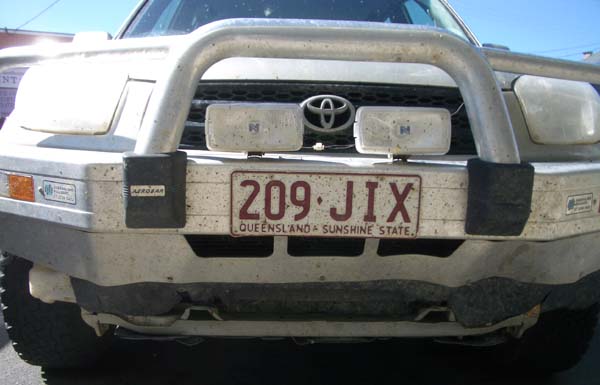 In the
hinterland, away from the frenzied coastline, life goes on
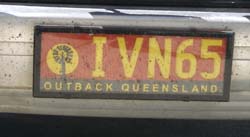 as always to the
tune of thousands of flies, mosquitoes and other bugs, especially at
dusk. Can the
flapping of a
butterfly's wings as it hits your license plate trigger a cyclone in
Indonesia, as chaos theory posits? We returned home by heading south
down the New England Highway, past dozens of timeless Australian towns
and miles of rolling pastoral landscape. This was a great trip
for examining the two distinct Australias: the coastal one
that is getting all the growth, and the iconic inland one whose economy
is
suffering from low rainfall, if not outright drought, and declining
populations.
as always to the
tune of thousands of flies, mosquitoes and other bugs, especially at
dusk. Can the
flapping of a
butterfly's wings as it hits your license plate trigger a cyclone in
Indonesia, as chaos theory posits? We returned home by heading south
down the New England Highway, past dozens of timeless Australian towns
and miles of rolling pastoral landscape. This was a great trip
for examining the two distinct Australias: the coastal one
that is getting all the growth, and the iconic inland one whose economy
is
suffering from low rainfall, if not outright drought, and declining
populations. |
| September 11, 2007:Today
was Canadian Prime Minister Stephen Harper's address to a joint session
of the Australian parliament. Harper had been in Sydney for APEC, and
stayed on to reciprocate Oz PM John Howard's address to the Canadian
parliament a year ago. I was quite interested in hearing news and
analysis of it, but it was like looking for a chook with a complete set
of teeth. Harper's presence, as with all the other news, has been overshadowed by the Coalition government's terrible showing in the polls and the rumour/suggestion that a party revolt will force Howard to resign before an election has to be called later this (southern) spring. Harper appeared in a number of TV clips (who is that guy next to Howard, anyway?) but the story was always Howard answering questions about his leadership. At least these were the clips that made it to the news. It was the same at APEC on the weekend. Howard was with Russian president Putin and the Australian press were allotted only two questions, and one was about whether Howard would resign after APEC. It's really hard to feel sorry for Howard at the best of times, but the media is so feral I almost did. The commercial stations didn't cover the Canadian visit at all, a situation that was duplicated by the Canadian media during the Howard visit. ABC and SBS, the two serious stations, did brief stories mainly focusing on the two countries trying to work more closely together in Afghanistan. It was a different scene during the APEC weekend, when Australia and the USA were arm in arm on their continuing involvement in Iraq and Canada was nowhere to be seen. Iraq is just one of the issues that will likely bring down the government -- according to the current polls, the election will be a landslide for Labour. -a roadtrip to Queensland beginning tomorrow will end the blog for a week or so. |
| September 9, 2007:
not much time for blogging lately ... -I had to spend four days in New Zealand at the beginning of the month as part of the process of getting permanent-resident status in ... yes, Australia. I don't make the rules, I just obey them. It provided another interesting lesson in isolation, in that New Zealand really feels like it's on the rim of the planet, rather like Tasmania. And, you realize why the Kiwis feel about the Aussies rather the way Canadians do about Americans. 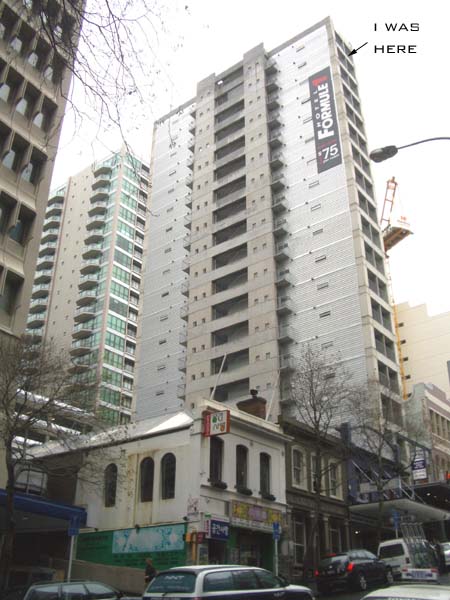 Hotel in Auckland, owned by a French company, rooms like little pods and cheap as chips, next door to Chinese cafe and "New Zealand's most extensive source of adult supplies." The population of New Zealand, about 4 million, is less than the population of Sydney. Auckland is 1.3 of the 4 million. Sorry for the Bill-Bryson-statistical-interlude there, but it does tell part of the story. As the weather was pretty dodgy, I didn't do much more than explore Auckland's inner neighbourhoods, which have the usual complement of Asian students, Starbuckses, and some wonderful wooden cottages like the ones in James Bay in Victoria, BC. The Maoris were especially notable, especially compared with the Aussie aborigines, as they are so integrated into the city while still maintaining their own separateness of language and culture, including a Maori TV channel. An amazing number of faces have some Polynesian/Maori features. And they are b - i - g people (in Sydney, many of the bouncers are Samoan). There were references to English being "the common language," which seemed much less dominating than "the official language," and many signs were bilingual English/Maori. One evening in my hotel room, tired of the fish and chips and beer and smoke of the nearby tavern, I was channel surfing, through all 4 of 'em, trying to find something to watch other than the All Blacks preparing to defend their world rugby title in Marseilles, and realized I was looking at the Fraser River in Langley. It was a documentary on the Sto:lo -- an episode of the CBC's The Nature of Things, the only show I came across on the Maori channel in "the common language." A group of Maoris and Native people from New Guinea and a few of the South Pacific islands went on a gig to British Columbia "to learn about the fishing methods of the Sto:lo." I've always admired the Sto:lo for their organization and their sense of their own history and culture, so it was interesting to hear the comments of the South Pacific Aboriginals: a few of them said they thought the Sto:lo had effectively lost their culture because so few of them could speak their language, Halkomelem. -I would have arrived back on time except the plane was put into a holding pattern in order to allow the arrival of dignitaries for APEC, which has completely dominated Sydney for the past several days. The tourist Sydney around the Opera House and Darling Harbour, and the northern part of the business district, were turned into an armed camp, with "The Great Wall of Sydney" -- a 3-metre high steel fence -- erected around kilometres of the downtown. The disruption of this super-high security was so complete that the government declared Friday a holiday for the 4.5 million people living between the ocean and the base of the Blue Mountains, emptying out the city but causing huge traffic jams as people tried to take advantage of an unexpected long weekend. I know it made the news in North America: the highlight was the stunt by an ABC comedy team from "The Chaser's War on Everything." They created a phony motorcade with Canadian flags on the cars and one of their members dressed as Osama bin Laden, and managed to get through two checkpoints before realizing that they were within metres of the sniper-ringed hotel where President Bush was staying. So they tried to turn around, "Osama" got out of the car, and amazingly nobody got shot, except digitally. All very funny and a wonderful set-up, but.... Yesterday (Saturday) was the big "Stop Bush/Get Out of Iraq" demo in Sydney. It was all pretty peaceful due at least partly to the overwhelming police presence. Australia's never seen the kind of draconian police powers that were legislated for this event. It will be interesting to hear the aftermath (and I don't mean Steven Harper's address to the Australian parliament on Tuesday). People seem to be genuinely annoyed by the cost and disruption of an event that only has resulted in a watered-down "Sydney Declaration" on climate change and some trade deals. Cost for security: $161 million. The guy who cuts my hair summed it up: "They should've held it in Canberra. The leaders could've stayed in their embassies. They could've put a wall around the government part of the city and nobody would've cared." -August was a bad flu month in Australia, with several people dying and lots more (like me) hacking and coughing for a few weeks. But it wasn't really big news on the TV and radio. Then, towards the end of the month, equine flu arrived in the country, ostensibly due to a quarantine error on a Japanese racehorse. Now this was serious! It led the TV and radio newscasts for several days, signs went up banning the transport of horses, the Victoria police put inspectors at all the border crossings from New South Wales, and there was a loud demand for a government enquiry and compensation. Not only did the flu outbreak threaten the stud industry, it has effectively cancelled the multi-multi-million dollar racing and betting industry in NSW and, now Queensland. But the blockade at the Victoria border has so far been effective, so Spring Carnival and the Melbourne Cup, the biggest events on the racing calendar, will go ahead. Aussies love sport, and gambling on sport, including racing of dogs, cars, horses, flies up a wall, whatever. |